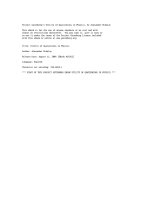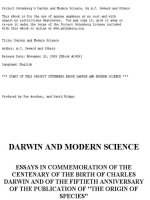Project Gutenberg''''s Elements of Agricultural Chemistry, by Thomas Anderson pdf
Bạn đang xem bản rút gọn của tài liệu. Xem và tải ngay bản đầy đủ của tài liệu tại đây (1.99 MB, 918 trang )
Project Gutenberg's Elements of
Agricultural Chemistry, by Thomas Anderson
This eBook is for the use of anyone
anywhere at no cost and with
almost no restrictions whatsoever. You may
copy it, give it away or
re-use it under the terms of the Project
Gutenberg License included
with this eBook or online at
www.gutenberg.org
Title: Elements of Agricultural Chemistry
Author: Thomas Anderson
Release Date: March 28, 2008 [EBook
#24931]
Language: English
*** START OF THIS PROJECT GUTENBERG EBOOK
ELEMENTS OF AGRICULTURAL CHEMISTRY ***
Produced by Steven Giacomelli, Jeannie
Howse, Josephine
Paolucci and the Online Distributed
Proofreading Team at
. (This file was
produced from images
produced by Core Historical Literature in
Agriculture
(CHLA), Cornell University).
ELEMENTS
OF
AGRICULTURAL
CHEMISTRY
BY
THOMAS
ANDERSON, M.D.
F.R.S.E., F.C.S.
PROFESSOR OF CHEMISTRY IN THE
UNIVERSITY OF GLASGOW, AND
CHEMIST TO THE HIGHLAND AND
AGRICULTURAL SOCIETY OF
SCOTLAND.
EDINBURGH:
ADAM AND CHARLES BLACK.
1860.
ERRATUM.
Page 190, line 11, for "gallon" read "ton."
PRINTED BY R. AND R. CLARK,
EDINBURGH.
Transcriber's note: Many of the
tables needed to be split to fit
space constraints.
PREFACE.
The object of the present work is to offer
to the farmer a concise outline of the
general principles of Agricultural
Chemistry. It has no pretensions to be
considered a complete treatise on the
subject. On the contrary, its aim is strictly
elementary, and with this view I have
endeavoured, as far as possible, to avoid
unnecessary technicalities so as to make it
intelligible to those who are unacquainted
with the details of chemical science,
although I have not hesitated to discuss
such points as appeared essential to the
proper understanding of any particular
subject.
The rapid progress of agricultural
chemistry, and the numerous researches
prosecuted under the auspices of
agricultural societies and private
experimenters in this and other countries,
render it by no means an easy task to make
a proper selection from the mass of facts
which is being daily accumulated. In
doing this, however, I have been guided
by a pretty intimate knowledge of the
wants of the farmer, which has induced me
to enlarge on those departments of the
subject which bear more immediately on
the every-day practice of agriculture; and
for this reason the composition and
properties of soils, the nature of manures,
and the principles by which their
application ought to be governed, have
been somewhat minutely treated.
In all cases numerical details have been
given as fully as is consistent with the
limits of the work; and it may be right to
state that a considerable number of the
analyses contained in it have been made in
my own laboratory, and that even when I
have preferred to quote the results of other
chemists, they have not unfrequently been
confirmed by my own experiments.
University of Glasgow,
1st November 1860.
CONTENTS.
Introduction
CHAPTER I.
The Organic Constituents of Plants.
Carbon Carbonic Acid Hydrogen
Nitrogen Nitric Acid Ammonia
Oxygen Sources whence obtained
The Atmosphere The Soil Source of
the Inorganic Constituents of Plants
Manner in which the Constituents of Plants
are absorbed
CHAPTER II.
The Proximate Constituents of Plants.
The Saccharine and Amylaceous
Constituents Cellulose Incrusting
Matter Starch Lichen Starch
Inuline Gum Dextrine Sugar
Mucilage Pectine and Pectic Acid
Oily or Fatty Matters Margaric, Stearic,
and Oleic Acids Wax Nitrogenous or
Albuminous Constituents of Plants and
Animals Albumen Fibrine Casein
Diastase
CHAPTER III.
The Changes which take place in the Food
of Plants during their Growth.
Changes occurring during Germination
Changes during the After-Growth of the
Plant Decomposition of Carbonic Acid
Decomposition of Water
Decomposition of Ammonia
Decomposition of Nitric Acid
CHAPTER IV.
The Inorganic Constituents of Plants.
The Amount of Inorganic Matters in
Different Plants The Relative
Proportions of Ash in the Different Parts
of Plants Influence of the Nature of the
Soil on the Proportion of Mineral Matters
in the Plant The Composition of the
Ashes of Plants Classification of
Different Plants
CHAPTER V.
The Soil—Its Chemical and Physical
Characters.
The Origin of Soils Composition of
Crystalline and Sedimentary Rocks
their Disintegration Chemical
Composition of the Soil Fertile and
Barren Soils Mechanical Texture of
Soils Absorbent Action of Soils their
Physical Characters Relation to Heat
and Moisture The Subsoil
Classification of Soils
CHAPTER VI.
The Improvement of the Soil by
Mechanical Processes.
Draining Its Advantageous Effects
Subsoil and Deep Ploughing Improving
the Soil by Paring and Burning Warping
Mixing of Soils Chalking
CHAPTER VII.
The General Principles of Manuring.
Fundamental Principles upon which
Manures are applied Special and
General Manures Importance of this
distinction Views regarding the Theory
of Manures Remarks on Special
Manures Action of Manures on the
Chemical and Physical Properties of a
Soil Remarks on the Application of
Manures
CHAPTER VIII.
The Composition and Properties of Farm-
yard and Liquid Manures.
Farm-yard Manure Urine
Composition of Dung Composition of
Farm-yard Manure Composition of
Management of Dung-Heaps Box-
feeding Fermentation and application of
Manure Liquid Manure Composition
and application of Sewage Manure
Its composition and application
CHAPTER IX.
The Composition and Properties of
Vegetable Manures.
Rape-Dust, Mustard, Cotton and Castor
Cake Composition of various Oil-
Cakes Malt-Dust, Bran, Chaff, etc.
Straw and Saw-dust Manuring with
Fresh Vegetable Matter Green
Manuring Sea-Weed Composition of
various Sea-Weeds Leaves Peat
CHAPTER X.
The Composition and Properties of
Animal Manures.
Guano, different varieties of Average
composition of Division into
Ammoniacal and Phosphatic Characters
of Adulteration of Application of
Pigeons' Dung Urate and Sulphated
Urine Night-Soil and Poudrette Hair,
Skin, Horn, Wool, etc. Blood Fish
"Fish-Guano"—Bones
CHAPTER XI.
The Composition and Properties of
Mineral Manures.
Mineral Manures Sulphate and Muriate
of Ammonia Sulphomuriate of
Ammonia Ammoniacal Liquor
Nitrates of Potash and Soda Muriate
and Sulphate of Potash Chloride of
Sodium, or Common Salt Carbonates of
Potash and Soda Silicates of Potash and
Soda Sulphate of Magnesia
Phosphate of Lime Bone-ash
Coprolites Apatite Sombrero Guano
Superphosphates and Dissolved Bones
Biphosphate of Lime or Soluble
Phosphates Phospho-Peruvian Guano
Lime Chalk Marl Application and
Action of Lime on Soils Sulphate of
Lime or Gypsum
CHAPTER XII.
The Valuation of Manures.
The Principle on which Manures are
valued Its application to different
simple and complex Manures Method
of Calculation General Remarks
CHAPTER XIII.
The Rotation of Crops.
Its necessity explained Quantity of
Mineral Matters in the produce of an Acre
of Different Crops The Theory of
Rotation
CHAPTER XIV.
The Feeding of Farm Stock.
The Principles of Feeding The
Composition of different Animals in
different stages of Fattening The
Composition of the Food of Animals
Milk The Principal Varieties of Cattle
Food General Observations on Feeding
AGRICULTURAL
CHEMISTRY.
INTRODUCTION.
That the phenomena of vegetation are
dependent on certain chemical changes
occurring in the plant, by which the
various elements of its food are
elaborated and converted into vegetable
matter, was very early recognised by
chemists; and long before the correct
principles of that science were
established, Van Helmont maintained that
plants derived their nourishment from
water, while Sir Kenelm Digby, Hook,
Bradley, and others, attributed an equally
exclusive influence to air, and enlarged on
the practical importance of the
conclusions to be deduced from their
views. These opinions, which were little
better than hypotheses, and founded on
very imperfect chemical data, are
mentioned by Jethro Tull, the father of
modern agriculture, only to deny their
accuracy; and he contended that the plants
absorb and digest the finer particles of the
earth, and attributed the success of the
particular system of husbandry he
advocated to the comminution of the soil,
by which a larger number of its particles
are rendered sufficiently small to permit
their ready absorption by the roots.
Popular opinion at that time was in favour
of the mechanical rather than the chemical
explanation of agricultural facts, and
Tull's work had the effect of confirming
this opinion, and turning attention away
from the application of chemistry to
agriculture. Indeed, no good results could
have followed its study at that time, for
chemistry, especially in those departments
bearing more immediately on agriculture,
was much too imperfect, and it was only
towards the close of the last century, when
Lavoisier established its true principles,
that it became possible to pursue it with
any prospect of success.
Very soon after Lavoisier's system was
made known, Lord Dundonald published
his "Treatise on the Intimate Connexion
between Chemistry and Agriculture," in
which the important bearings of the recent
chemical discoveries on the practice of
agriculture were brought prominently
under the notice of the farmer, and almost
at the same time De Saussure commenced
those remarkable researches, which
extended over a long series of years, and
laid the foundation of almost all our
accurate knowledge of the chemistry of
vegetation. Saussure traced with singular
care and accuracy the whole phenomena
of the life of plants, and indicated the
mode in which the facts he established
might be taken advantage of in improving
the cultivation of the soil. But neither his
researches, nor Lord Dundonald's more
direct appeal to the farmer, excited the
attention they deserved, or produced any
immediate effect on the progress of
agriculture. It was not till the year 1812
that the interest of practical men was
fairly awakened by a course of lectures
given by Sir Humphrey Davy, at the
instance of Sir John Sinclair, who was at









